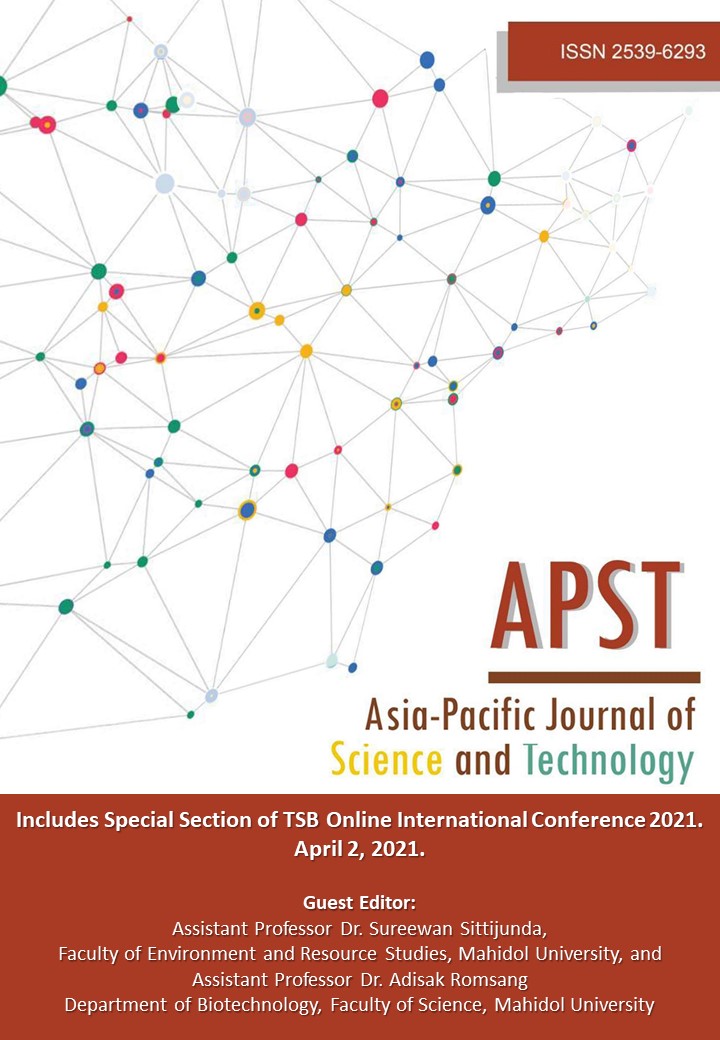Environmental and economic analysis of a biodiesel power plant derived from the fast pyrolysis of empty fruit bunches
Main Article Content
Abstract
As a major waste biomass from the palm oil mill process, empty fruit bunches (EFBs) are a potential energy source. This study analyses the environmental and economic impact of biofuel in the fast pyrolysis of EFBs to produce 100 kW of electricity. Aspen Plus commercial simulation provided 100 tons/day of dried EFBs to produce bio-oil, char, and gas at 74.4, 12.1, and 13.5 tons/day, respectively. From the economic perspective, the net present value (NPV), internal rate of return (IRR), and payback period (PBP) for this number of EFBs equate to USD10.71 M, 10.4%, and 13.18 years, respectively, based on 20 years of life and a total capital investment of USD36.26 M. The PM2.5 formation from the process is 19.6 tons PM2.5 eq (equivalent)/year in terms of environmental impact. In addition, the process results indicate significant greenhouse gas emissions of 44,608 tons CO2 eq (carbondioxide equivalent)/year. In comparison, landfill or direct EFB combustion can reduce CO2 emissions by 69,964- and 10,446-tons CO2 eq/year, respectively. Damage to human health, represented by disability-adjusted loss of life years, is about 0.11, while damage to ecosystem diversity, representing species loss during a year, is around 0.125. In both cases, the damage incurred by EFB fast pyrolysis is lower than landfill and direct EFB combustion.
Article Details

This work is licensed under a Creative Commons Attribution-NonCommercial-NoDerivatives 4.0 International License.
References
Krungsri Research Industry. Industry Outlook 2020-2022: Palm Oil Industry [Internet]. https://www. krungsri.com/en/research/industry/; 2020 [Accessed 27 January 2021].
Adams P, Bridgwater T, Lea-Langton A, Ross A, Watson I. Biomass Conversion Technologies. In: Patricia T, Paul A, editors. Greenhouse Gas Balances of Bioenergy Systems, Academic Press; 2018, p. 107-139.
Dinesh M, Charles U, Pittman J, Philip H. Pyrolysis of wood/biomass for bio-oil: a critical review. Energ Fuel. 2006;20:848-889.
Chiaramonti D, Oasmaa A, Solantausta Y. Power generation using fast pyrolysis liquids from biomass. Renew Sust Energ Rev. 2007;11:1056-1108.
Kerdsuwan, S, Laohalidanond K. Renewable energy from palm oil empty fruit bunch. Renew Energ: Trends and Applications. 2011;6:123-150.
Abdullah N, Sulaiman F. The properties of the washed empty fruit bunches of oil palm. J Phys Sci. 2013;24:117-120.
Ali N, Saleem M, Shahzad K, Hussain S, Chughtai A. Effect of operating parameters on production of bio-oil from fast pyrolysis of maize stalk in bubbling fluidized bed reactor. Pol J Chem Technol. 2016;18: 88-96.
Peters J, Banks S, Bridgwater A, Dufour J. A kinetic reaction model for biomass pyrolysis processes in Aspen Plus. Appl Energy. 2017;188:595-603.
Luo Y, Guda V, Steele P, Wan G. Hydrodeoxygenation of oxidized and hydrotreated bio-oils to hydrocarbons in a fixed-bed continuous reactor. Bioresources. 2016;11:4415-4431.
Sadhukhan J, Siew NK. Economic and European Union environmental sustainability criteria assessment of bio-oil-based biofuel systems: refinery integration cases. Ind Eng Chem Res. 2011;50:6794–6808.
Vathakit K. A study of boost pressure on efficiency of an agricultural single cylinder diesel engine – theory and calculations. In: The 13th Thai Society Agricultural Engineering; 2012 Apr 4-5; Chiang Mai province; 2012. p. 191-200.
Jones SB, Valkenburg C, Walton CW, Elliott DC, Holladay JE, Stevens DJ, et al. Production of gasoline and diesel from biomass via fast pyrolysis, hydrotreating and hydrocracking: a design case. Richland (WA): USDOE; 2009.
Wright M, Daugaard M, Satrio DE, Brown RC. Techno-economic analysis of biomass fast pyrolysis to transportation fuels. Fuel. 2010;89:2–10.
Mobolaji B, Shemfe SG, Panneerselvam R. Techno-economic performance analysis of biofuel production and miniature electric power generation from fast biomass pyrolysis and bio-oil upgrading. Fuel. 2015;143:361-372
Huijbregts M, Steinmann Z, Elshout P, Stam G, Verones F, Vieira M. ReCiPe2016: a harmonized life cycle impact assessment method at midpoint and endpoint level. Int J Life Cycle Assess. 2016;22:138-147.


